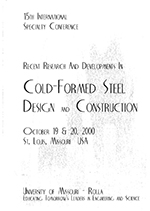Session Dates
19 Oct 2000
Abstract
This paper deals with the lateral buckling of prismatic members whose position of the axis of rotation is imposed by the conditions of lateral support. As a function of the type of connection with the lateral support, the rotation may be free or hindered (elastic end restraint). This may concern, for instance, the case of a purlin stabilized by a roof structure or of a column stabilized by an external cladding or by another type of efficient continuous bracing. Usually, the check of this type of instability is complex and leads to sophisticated and tedious computations. In order to avoid this inconvenience, approached solutions are often used. One of the most frequently used consists in calculating the compressed member as being fictitiously separated, submitted to lateral buckling in an elastic medium. The stiffness of this fictitious member is taken equal to its stiffness in lateral bending. The present paper proposes an improved behaviour model of members submitted to lateral buckling through which the stiffness of the fictitious member is determined by taking into account the torsional stiffness of the whole transverse section of the profile.
Department(s)
Civil, Architectural and Environmental Engineering
Research Center/Lab(s)
Wei-Wen Yu Center for Cold-Formed Steel Structures
Meeting Name
15th International Specialty Conference on Cold-Formed Steel Structures
Publisher
University of Missouri--Rolla
Document Version
Final Version
Rights
© 2000 University of Missouri--Rolla, All rights reserved.
Document Type
Article - Conference proceedings
File Type
text
Language
English
Recommended Citation
Sokol, Leopold K., "Lateral Buckling of Prismatic Members About an Imposed Axis of Rotation" (2000). CCFSS Proceedings of International Specialty Conference on Cold-Formed Steel Structures (1971 - 2018). 4.
https://scholarsmine.mst.edu/isccss/15iccfss/15iccfss-session3/4
Lateral Buckling of Prismatic Members About an Imposed Axis of Rotation
This paper deals with the lateral buckling of prismatic members whose position of the axis of rotation is imposed by the conditions of lateral support. As a function of the type of connection with the lateral support, the rotation may be free or hindered (elastic end restraint). This may concern, for instance, the case of a purlin stabilized by a roof structure or of a column stabilized by an external cladding or by another type of efficient continuous bracing. Usually, the check of this type of instability is complex and leads to sophisticated and tedious computations. In order to avoid this inconvenience, approached solutions are often used. One of the most frequently used consists in calculating the compressed member as being fictitiously separated, submitted to lateral buckling in an elastic medium. The stiffness of this fictitious member is taken equal to its stiffness in lateral bending. The present paper proposes an improved behaviour model of members submitted to lateral buckling through which the stiffness of the fictitious member is determined by taking into account the torsional stiffness of the whole transverse section of the profile.



